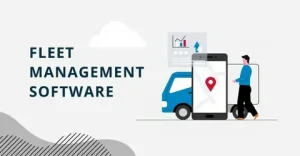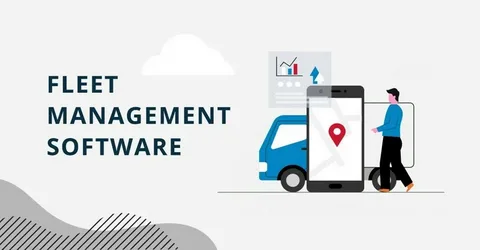Technology is the second thing that logistics leaders are doubling down on, and rightfully so. In 2025, the global fleet management market alone is already worth USD 28.4 billion, and it is projected to grow rapidly as fleets are under pressure to modernise due to the increasing demands of e-commerce, last-mile delivery, and electrification.
Patterns in adoption indicate that software is replacing manual systems. A 2025 industry survey discovered that three out of every four fleets now operate dedicated maintenance software, while many still use spreadsheets and paper—a gap that can be bridged by custom tools, which can operate end-to-end. Meanwhile, venture and corporate investments in logistics technology—whether it be AI routing startups, predictive-maintenance platforms, and so forth—point to an apparent ROI narrative associated with fleets investing in digital capabilities.
Logistics is now a margin game, a data game, and a time game. Commercial-off-the-shelf systems tend to address generic issues. Still, they cannot be configured to fit onto the specific routes of a carrier, its regulatory environment, its vehicle mix, or its legacy systems. This is where Custom Software Development Solutions come in: they enable fleets to transform disorganised data into actionable dashboards, automate exception workflows, and integrate compliance and local regulations into each route. To logistics leaders, custom tools do not imply new screens, but rather fewer delays, increased utilisation, and quantifiable cost reductions.
Why “one-size-fits-all” fails for modern fleets
Big fleets are heterogeneous. They have mixed vehicle classes (ICE, EV, trailers), operate within the borders of several states or nations, and handle niche loads (temperature-controlled, hazardous). Shelf-of-the-shelf offerings will always have trade-offs: manual workarounds, redundant data entry, or costly custom integrations that are often attended to by vendors as an add-on. That adds to TCO and retards adoption.
The business-centred custom fleet management platform features telematics ingestors dedicated to fleet OEMs, in-house maintenance modules because of the in-house SOPs, and dashboards featuring KPIs that the COO utilizes. The outcome is reduced conflict between operations and tech, accelerated driver onboarding, and enhanced compliance reporting, which leads to reduced fines, reduced downtime, and enhanced customer SLAs.
Tangible benefits logistics leaders are seeing
.1. Lower fuel and operating costs- Live route optimization, idling, and driver coaching eliminate fuel expenditure, which is often the single biggest variable in the fleet’s budget. Telematics and analytics feed such changes as idle hotspots and inefficient routing patterns emerge.
- Reduced downtime through predictive maintenance- By using AI to process sensor streams, companies can identify problems sooner and plan maintenance before the failure of one system leads to a cascade of failures, causing an extended, costly outage. Large operators have said that unscheduled downtime has fallen due to the adoption of predictive tools.
- Higher asset utilization and revenue per truck- In some applications, dispatch and load matching powered by machine learning can improve the economics of the fleet by increasing weekly truck revenue by double-digit percentages.
- Stronger compliance and safety- HOS, vehicle inspection and driver scorecard custom modules make audits quicker and less risky to regulatory.
- Future-proofing for electrification and sustainability- EV range, charging schedules, and overall cost of ownership can be modelled as custom solutions necessary for fleets which switch to low-emission vehicles.
Why many logistics leaders choose a Custom Software Development Company
There are several reasons why India has emerged as a preferred engineering partner in the logistics technology space: its rich engineering talent, experience in large-scale enterprise systems, and cost-efficient delivery models. A software development company is capable of quickly prototyping MVPs, connecting global telematics APIs, and offering 24/7 time zone-spanning engineering services at a sensible development cost. In combination with powerful product management and domain knowledge, these partners provide production-grade fleet solutions that meet international compliance and security requirements.
Building blocks of a successful custom fleet solution
- Powerful data capture: CAN bus, OBD-II, OEM telematics, dashcams and mobile app connectors.
- Smart dispatching and routing: Live traffic, limits (man-hours, truck capacity), and customer time windows.
- Predictive: Sensor analytics, fault detection and work-order generation.
- Driver experience: e-POD, digital DVIRs, and coaching nudge mobile apps.
- Analytics & KPIs: Customizable dashboards that display revenue per truck, utilization, on-time percentage, and green data.
- Integrations: ERP, WMS, TMS, payroll and brokerage to eliminate manual handoffs.
How to measure success (KPIs every logistics leader should track)
- Fuel price per delivery / per mile.
- Time delivery rate and compliance with SLA.
- Average amount of downtime per vehicle/month
- Revenue per truck per week
- Total cost to ownership (software and operations) vs pre-implementation baseline.
Best practices when procuring a custom solution
- Do not begin with features, but with results. State target KPIs (e.g. save 8% of fuel spend in 12 months).
- representative subset Pilot. Test integrations, data integrity and driver processes before rollout.
- Select a partner that has domain chops. Find engineering teams that have previously developed telematics, routing, or maintenance solutions – many well-established Custom Software Development Companies in India now have logistics as a core vertical.
- Go first to modular architecture. With microservices and APIs, it is also easier to scale to or replace components as requirements change.
- Design continuous improvement. Software is never complete at the release date; continue with telemetry to develop features that move the KPIs.
The future: AI, edge compute, and autonomous workflows
Corporate funding and investment trends indicate that the industry is accelerating rapidly: logistics players and investors are supporting AI platforms that align loads, predict demand, and coordinate assets with minimal human interference. According to McKinsey and other industry analysts, digital logistics investments are gaining momentum as firms seek agility and resilience in an unstable market.
Custom solutions provide fleets with the flexibility to implement breakthroughs at their own pace, adding AI routing and edge analytics for inference on the vehicle, as well as autonomous exception handling to workflows, without relying on a single vendor’s roadmap.
Conclusion
Indeed, to logistics leaders who view success in terms of margins, uptimes, and customer commitments, custom fleet management tools are no longer a nice-to-have, but a strategic necessity. In collaboration with highly qualified engineering teams from many reputable custom software development companies, operators can transform raw telematics and operational data into predictable results. When your fleet is still operating on spreadsheets and hope, a specialised custom software development solution might be the only lever large enough to increase efficiency, decrease costs, and scale sustainably in the current fast-paced logistics environment.

